Gradient-Index (GRIN) Lenses for Imaging
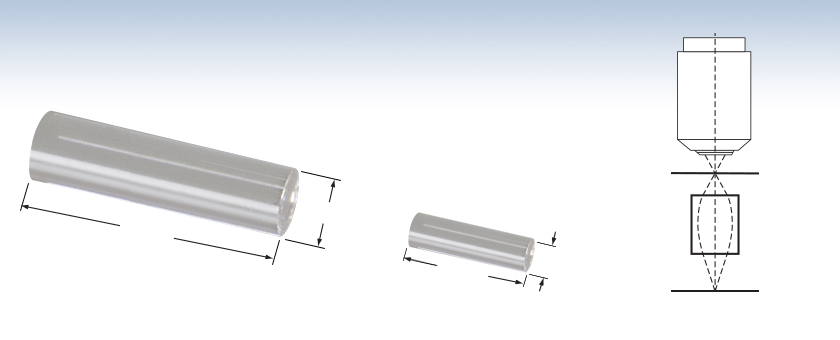
- Gradient-Index Lenses for Widefield, Confocal, or Multiphoton Microscopy
- Water Coupling on Sample Side and Air Coupling on Objective Side
- Uncoated or Broadband AR-Coated Versions
GRIN Lens
Microscope Objective
Sample Plane
Our GRIN lenses can be used as a 1:1 imaging relay between the objective lens and the sample.
Intermediate
Image Plane
G1P10
GRIN Lens, Uncoated
G2P11
GRIN Lens, AR-Coated for
515 - 670 nm and 900 - 1100 nm
Ø1.0 mm
3.758 mm
Ø0.5 mm
1.883 mm

Please Wait
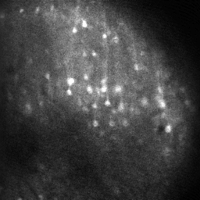
Click to Enlarge
500 µm Field of View
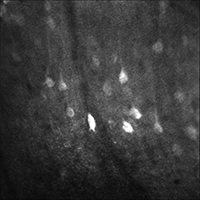
Click to Enlarge
200 µm Field of View
Neuronal activity in an awake mouse. Both laser-scanned multiphoton images used the G2P10 GRIN lens implanted 3 mm deep and a 20X, 0.5 NA Nikon Objective Lens. (Images courtesy of Dr. Mackenzie Mathis, Rowland Institute, Harvard University.)
Features
- Use as Implantable Lens Elements for In Vivo Imaging Applications
- Ideal for Widefield, Confocal, or Multiphoton Microscopy
- Ø1.0 mm Uncoated Lenses
- Ø0.5 mm or Ø1.0 mm AR-Coated Lenses for 500 - 1000 nm, or 515 - 670 nm and 900 - 1100 nm
Thorlabs' gradient-index (GRIN) lenses are available for imaging applications in which the region of interest is inaccessible with a microscope objective. These GRIN lens can be implanted deeply into a target specimen with minimal invasiveness and load. We offer Ø1.0 mm uncoated lenses that are ideal for widefield and laser-scanned confocal imaging. These lenses have high transmission over a wide wavelength range. We also have available Ø0.5 mm or Ø1.0 mm broadband AR-coated lenses that are ideal for multiphoton imaging. The Ø1.0 mm lens is AR-coated for 500 - 1000 nm, while the Ø0.5 mm lens is AR-coated for 515 - 670 nm and 900 - 1100 nm. For more specifications on each lens, please see the Specs tab.
Unlike a traditional lens, a GRIN lens affects the optical path by varying the index of refraction within the lens itself. In contrast to a spherical or aspheric lens, all optical path lengths (refractive index multiplied by distance) are the same in a GRIN lens due to the radially varying refractive index. For information on how to calculate the refractive index as a function of radius, please see the Specs tab.
| Item # | G1P10 | G1P11 | G2P10 | G2P11 |
|---|---|---|---|---|
| Design Wavelength | 550 nm | |||
| AR Coating Range (Both Ends) |
N/A | 500 - 700 nm, Ravg < 0.5% 700 - 1000 nm, Ravg < 1.5% |
515 - 670 nm and 900 - 1040 nm, Ravg < 1% 950 - 1100 nm, Ravg < 2.5% |
|
| Working Distancea | 0.20 mm on Sample Side (Water Immersion) and on Objective Side (Dry) | 0.25 mm on Sample Side (Water Immersion) 0.19 mm on Objective Side (Dry) |
0.20 mm on Sample Side (Water Immersion) and on Objective Side (Dry) |
|
| Viewing Angle (Max) | 70° | 50° | ||
| Refractive Index (n1) @ 550 nm |
1.666 | 1.333 | ||
| Gradient Constant (√A) @ 550 nm |
0.724 mm-1 | 0.782 mm-1 | 1.291 mm-1 | |
| Pitchb (P) @ 550 nm |
0.433 | 0.933 | 0.423 | 0.387 |
| Face Angle | 0° | |||
| Numerical Aperture (NA) in Water | 0.50 | 0.486 | ||
| Magnificationc | -0.92 | +0.98 | -1 | +0.96 |
| Length (Z) | 3.758 mm ± 0.500 mm |
8.091 mm ± 1.100 mm |
3.400 mm ± 0.085 mm | 1.883 mm ± 0.620 mm |
| Diameter (D) | 1.0 mm +0/-0.03 mm | 1.0 mm +0/-0.05 mm | 0.5 mm +0/-0.03 mm | |
| Field Curvatured | 100 µm | 50 µm | ||
| Polarization Preservation | Not Specified | |||
| Protective Coating | SiO2 (Silica) | N/A | ||
| Operating Temperature |
<350 °C | <200 °C | <350 °C | |
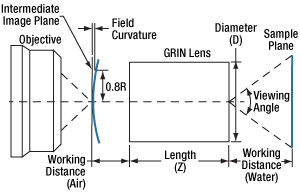
Click to Enlarge
An example setup when imaging with an arbitrary GRIN lens.
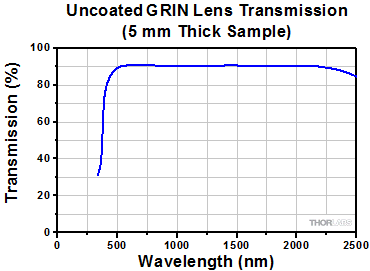
Click to Enlarge
Transmission for G1P10 and G1P11 Uncoated GRIN Lenses
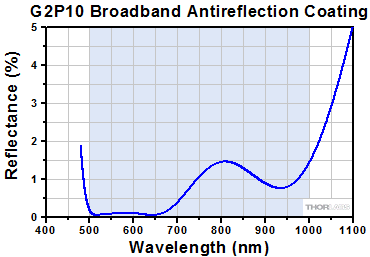
Click to Enlarge
Click Here for Raw Data
AR Coating Reflectance for the G2P10 Lens. The blue shaded region denotes the specified wavelength range for optimum performance.

Click to Enlarge
Click Here for Raw Data
AR Coating Reflectance for the G2P11 Lens. The blue shaded region denotes the specified wavelength range for optimum performance.
Index as a Function of Radius
The index as a function of radius, as shown in the diagram to the lower left, may be calculated with the equation:
where n1 is the index of refraction on the optical axis, √A is the gradient constant, and r is the radial position (ranging from -D/2 to +D/2, where D is the diameter). The refractive index decreases quadratically as the radial position from the center increases. The steepness of the parabolic drop depends on the gradient constant.
Relating Pitch and Lens Length
The pitch and length of a GRIN lens may be related using the following equation:
where P is the pitch of the lens, Z is the length of the lens, and √A is the gradient constant. The pitch of the lens is the fraction of a full sinusoidal period that the ray traverses in the lens; see the diagram below (center).
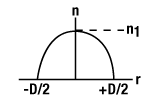
Click to Enlarge
Refractive Index Profile of a GRIN Lens
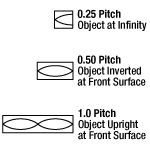
Click for Details
GRIN Lenses with Different Pitches. As the length of the lens increases, the pitch increases. For lenses with a pitch that is not an integer multiple of 0.25, the object and image planes are at non-zero working distances (WD) from the surfaces of the lens.
Handling
A GRIN lens should be handled with stainless steel tweezers, preferably those with a tapered end like our TZ3 optic tweezers, and picked up by firmly grasping the side of the cylinder rather than the flat ends.
Cleaning
Use methyl alcohol as a cleaning solvent when necessary. Acetone may also be used without harm to a GRIN lens, but should be pure enough to not leave a residue on the lens surface.
Storage
For extended periods of time, a GRIN lens should be stored in a "dry box" environment. This entails the use of a desiccant or heat source to prevent humidity from leaching the lens material. For short-term storage (less than a month), the plastic box and foam packing in which the lens is shipped will provide adequate storage, provided the lens is placed securely in the built-in slot to avoid chipping or scratching from other lenses.
| Posted Comments: | |
user
(posted 2024-05-13 08:56:50.16) At what working distance is the G2P11 magnification 0.96? cdolbashian
(posted 2024-05-14 08:42:01.0) Thank you for reaching out to us with this inquiry. Looking at the 'Specs' tab, we show that you must create a working distance of 200um on both the water immersion side (sample side) and the air side (Objective side) in order to achieve the 0.96 magnification. We share a figure on the same 'Specs' tab on the product page above, which should assist with placement of your optics. If you have further usage inquiries, please feel free to contact us at techsupport@thorlabs.com. Jong Cheol Rah
(posted 2024-01-15 18:44:33.6) As the target brain area of our study is about 3.2 mm deep, we would like to have the same coating as G2P10 but with the length of G1P11.
Would it be possible to customize G2P10 for us?
Cheers
JC ksosnowski
(posted 2024-01-17 10:55:49.0) Hello JC, thanks for reaching out to Thorlabs. I have reached out directly to discuss the possibility of offering these custom options. Susan Thomas
(posted 2022-04-11 12:32:12.353) I would like to buy G2P10 lens for imaging in a fiber-based confocal endoscopy setup. I want to know whether there are any sleeves and pigtailed ferrules and V clamps for mounting and holding these GRIN lenses. jgreschler
(posted 2022-04-14 04:39:12.0) Thank you for reaching out to Thorlabs. For this application we recommend using the VK250(/M) micro V clamp to secure the GRIN lens. Susan Thomas
(posted 2022-02-22 12:31:35.82) Hi, I am planning to buy GRIN lenses to design and build optics for a two-photon micro-endoscope. I see that single wavelength GRIN lenses are of larger diameter (1.8mm) I suppose GRIN imaging lenses are suitable for my application. I could find single wavelength GRIN as catalog lenses in Zemax, but imaging lenses such as G2P10 and G2P11 were not available as catalog lenses. Is there a way to model these lenses in Zemax? Will it be possible to change the pitch of GRIN lens as per my requirement for these lenses?
If not, Can you suggest some other vendors who can offer this? cdolbashian
(posted 2022-02-28 10:45:23.0) Thank you for reaching out to us Susan. Unfortunately, due to the manufacturing and design process of these lenses, we cannot provide you with any Zemax files for simulation. I will reach out to you directly to discuss your other inquiries. Jesse Jackson
(posted 2021-01-21 12:18:06.28) Hi
We love these lenses for doing in vivo 2P calcium imaging (on our Bergamo). But it would be great to have a 0.5mm diameter lens, for less invasive brain imaging. Any chance that's in development? YLohia
(posted 2021-01-26 02:58:10.0) Hello, thank you for your feedback. Unfortunately, we don't have a 0.5 mm version of the G1P10 at the moment (closest alternative currently is the G2P11). I have posted your request on our internal engineering forum for further consideration as a future product. tgeorges
(posted 2018-10-11 09:55:44.97) Would it be possible to have a coating for 450nm wavelength? YLohia
(posted 2018-10-11 09:39:39.0) Hello, thank you for contacting Thorlabs. I will reach out to you directly to discuss the possibility of offering a custom version of this. kyrollosyanny
(posted 2018-08-26 22:16:17.03) This lens will be a lot more useful if it was infinity corrected. Many people in the field of neuroscience use headmonted microscopes (miniscope.org), having a 1.8 or 2mm diameter infinity corrected GRIN is very useful in that regard and it is an area with huge demand YLohia
(posted 2018-08-28 11:32:23.0) Hello, thank you for your feedback. I have posted this new product idea on our internal engineering forum for further consideration. mlippert
(posted 2018-07-14 11:56:13.65) I can only reinforce dennis' opinion. This is exactly what the field needs! People are looking for lenses to image mouse hippocampus, cortex with attached 1 mm microprisms as well as various deep brain structures (in our case mouse VTA), so various lengths and thicknesses would be ideal (thickness 1mm and 2 mm for short lenses, 0.5 mm and 0.3 mm for long (ca. 5-7mm lenses)), focal distance in tissue desn't need to exceed 150 um. A company with "opix" in its name has cornered everybody not using their system by supposedly blocking the release of the Grintech lenses to non-customers (at least its hard to get them). There is widespread discontent in the community regarding these business practices which many consider unethical.
Gofoton is apparently looking at making equivalent lenses, but regardless of manufacturer, it would be amazing to have an independent manufacturer of imaging lenses for the purpose. If you have any candidate lenses, we would always be willing to test them in our lab with one of our systems. YLohia
(posted 2018-07-19 09:50:21.0) Hello, thank you for your valuable feedback. I have posted this idea on our internal engineering forum for further consideration. dennis.kaetzel
(posted 2017-09-17 21:27:24.387) Dear Thorlabs,
it would be fantastic, if you could offer a range of imaging GRIN lenses that are for chronic implantation (uncoated) and permissive to blue exctitation light as required for MOST applications of those lenses for imaging in life rodents (single-photon, implanted miniscopes). There is only one supplier (GRINtech) of GRIN lenses with a 4th order index of refraction profile, i.e. of high quality ... and that supplier does not sell those lenses for imaging application due to a contract with Inscopics. At the same time, the demand for this technology is surging dramatically as dozens, if not hundreds of labs are starting to use the Miniscope Technology.
What would be required are lenses with 0.25 pitch (for the cope) and uncoated lenses with 0.4 pitch and 0.5mm Working Distance and a diameter of 1mm and 0.5 or 0.6mm. You can contact me for more info. tfrisch
(posted 2017-10-05 12:01:31.0) Hello, thank you for contacting Thorlabs. GRIN lenses for single photon and water immersion are a part of an open discussion we have internally. I will reach out to you with more details on what you'd be looking for in the future. |


Click to Enlarge
Transmission for G1P10 and G1P11 Uncoated GRIN Lenses
- Ideal for Widefield and Laser-Scanned Confocal Imaging
- G1P10: Ø1.0 mm and 3.758 mm Long
- G1P11: Ø1.0 mm and 8.091 mm Long
- Working Distance:
- 0.20 mm on Sample Side (Water Immersion)
- 0.20 mm on Objective Side (Dry)
- 0.50 Numerical Aperture in Water
These uncoated GRIN lenses feature a 0.20 mm working distance on both the sample and the objective side. Each lens is 1.0 mm in diameter and ideal to be used in widefield and laser-scanned confocal imaging. The G1P10 lens is 3.758 mm long, while the G1P11 lens is 8.091 mm long. Each lens provides a large collection angle due to a numerical aperture of 0.50 in water. See the Specs tab for more details on optical properties.


Click to Enlarge
Click Here for Raw Data
AR Coating Reflectance for the G2P10 Lens. The blue shaded region denotes the specified wavelength range for optimum performance.
- Ideal for Widefield, Confocal, and Multiphoton Imaging
- Ø1 mm and 3.400 mm Long
- Working Distance:
- 0.25 mm on Sample Side (Water Immersion)
- 0.19 mm on Objective Side (Dry)
- 0.50 Numerical Aperture in Water
This GRIN lens features a 0.25 mm working distance on the sample side and a 0.19 mm working distance on the objective side. It has a broadband AR coating optimized for 500 - 1000 nm. Suitable for excitation wavelengths from 800 to 1000 nm, the AR coating extends down to 500 nm to reduce losses for the corresponding emission wavelengths. This range is useful for Ca2+ imaging. The lens supports widefield imaging techniques to locate the target region of interest (ROI), as well as confocal and multiphoton laser scanning of the sample. At 1.0 mm in diameter and 3.400 mm in length, the GRIN lens provides a large collection angle due to a numerical aperture of 0.50 in water. See the Specs tab for more details on optical properties.


Click to Enlarge
Click Here for Raw Data
AR Coating Reflectance for the G2P11 Lens. The blue shaded region denotes the specified wavelength range for optimum performance.
- Ideal for Multiphoton Imaging
- Ø0.5 mm and 1.833 mm Long
- Working Distance:
- 0.20 mm on Sample Side (Water Immersion)
- 0.20 mm on Objective Side (Dry)
- 0.486 Numerical Aperture in Water
This GRIN lens features a 0.20 mm working distance on both the sample and the objective side. It is designed to minimize losses for excitation wavelengths from 900 - 1100 nm and emission wavelengths from 515 - 670 nm, which is useful for eGFP and eYFP. At 0.5 mm in diameter and 1.883 mm in length, this GRIN lens provides a large collection angle due to a numerical aperture of 0.486 in water. See the Specs tab for more details on optical properties.
 Products Home
Products Home











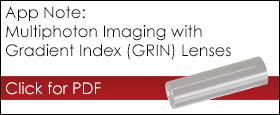

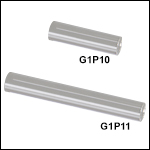
 Zoom
Zoom
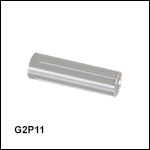
 GRIN Lenses for Imaging
GRIN Lenses for Imaging